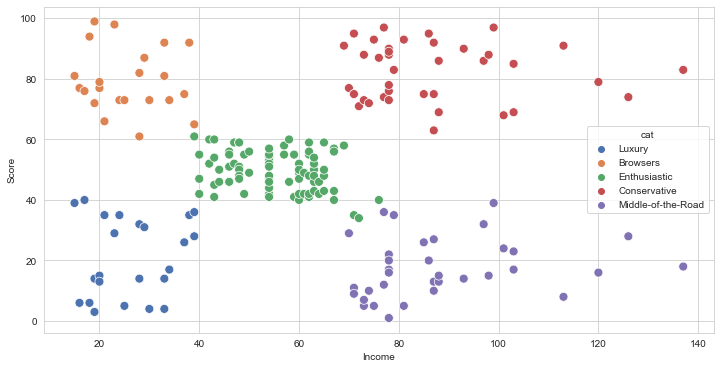KMeans¶
For the case study, we try to discover meaningful customer groups for market segmentation.
Import Python libraries¶
# import libraries
import pandas as pd
from sklearn.cluster import KMeans
import matplotlib.pyplot as plt
import seaborn as sns
sns.set_style("whitegrid")
Load and verify data¶
Next, we load and verify the data. Although there are four columns, we only use Income and Score for clustering. Income is the customer’s personal income. Score is an indexed score of how much the customer spends at the mall.
df = pd.read_csv("data/mallcustomers.csv")
df.head()
| Gender | Age | Income | Score | |
|---|---|---|---|---|
| 0 | Male | 19 | 15 | 39 |
| 1 | Male | 21 | 15 | 81 |
| 2 | Female | 20 | 16 | 6 |
| 3 | Female | 23 | 16 | 77 |
| 4 | Female | 31 | 17 | 40 |
Run K-Means¶
Next, we run \(K\)-Means with \(k\) (number of clusters) set at \(k=5\).
X = df[['Score','Income']]
km = KMeans(n_clusters=5).fit(X)
results = km.predict(X)
clusters = pd.DataFrame(results,columns=['cluster'])
df_c = X.join(clusters, how='outer')
df_c.head()
| Score | Income | cluster | |
|---|---|---|---|
| 0 | 39 | 15 | 4 |
| 1 | 81 | 15 | 3 |
| 2 | 6 | 16 | 4 |
| 3 | 77 | 16 | 3 |
| 4 | 40 | 17 | 4 |
category = {0:'Enthusiastic', 1:'Conservative',
2:'Middle-of-the-Road', 3:'Browsers',4:'Luxury'}
df_c['cat'] = df_c['cluster']
df_c = df_c.replace({'cat':category})
Display Results¶
plt.figure(figsize=(12,6))
sns.scatterplot(x="Income",y="Score",data=df_c,hue="cat",
palette="deep", s=80)
<AxesSubplot:xlabel='Income', ylabel='Score'>

